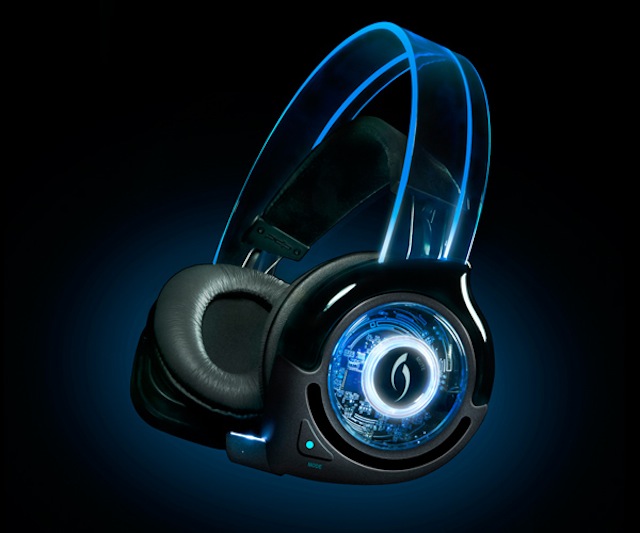Review: Value Gaming Headsets from Sony, Skullcandy, Sennheiser and PDP Page 4
 PDP Afterglow
PDP Afterglow
Unboxing the PDP Afterglow headset, I was worried it would be more style than substance, given the blue LEDs illuminating the earcup and the translucent frame. Yeah, they look cool, but unless you're gaming in front of a mirror, that doesn't matter. I was also wary of how they'd sound, as they're the only wireless set I've seen for under $100. Those fears, luckily, proved largely unfounded.
Controls for volume, voice/audio balance and sound mode all reside on the left earcup and are compact, but still easy to adjust while still wearing the headset. A light at the end of the retractable boom mic changes color to indicate which sound mode you're using, a feature that was helpful, but distracting; having the LED in my peripheral vision was hard to ignore even during longer sessions. The overall lighting of the headset reflected off my Panasonic GT25's screen in a darkened environment, which could very well be a deal breaker for some.
Setup is simple. All I had to do was plug the RCA audio connections into the requisite dongle for the 360, and then plug the transmitter into a USB port on the system. The instructions say to use one of the front ports, but I can't understand why when the receiver is oversized and prevents you from using the other port. Also, when the headset isn't powered on the receiver blinks incessantly. Yes, that means if your console is off, it'll keep blinking: all the more reason to plug it into a rear USB port.
The headset isn't for people with larger noggins, though. Because of its design, the soft headband within the frame didn't extend nearly enough for me to wear them in the straight up and down position comfortably. To even use the set, I had to tilt it back at a 45-degree angle, which meant that they pinched the stems of my glasses and caused my specs to lift off the bridge of my nose. Wearing 3D glasses would be even worse. Audio quality from the mic was less than ideal, with my friends telling me I needed to switch to another headset due to interference and feedback. And during quiet passages, there's more white noise, even at low volumes, than I'm comfortable with. Once whatever game I was playing kicked in, though, I didn't notice it whatsoever.
But those issues aside, what impressed me the most about the Afterglows is how they sounded. The three EQ modes - flat, bass boost, surround - are distinctive, although I settled on the simulated surround for my demo. The DSP was plenty convincing, too. In the opening sequences of American Revolution-era Assassin's Creed III, both the theater and Boston-bound ship drip with ambience, and the Afterglows had no problem reproducing it. Every creak and groan caused by the frigid Atlantic waters sounded great, with sea spray and gale-force winds sounding especially convincing as the protagonist bounded up the masts, dropped sails, and rummaged below decks.
Halo 4 sounded killer, too. Weapons retained their percussive grunts and barks while the robotic Promethean enemies and their shrill cries made me wince. Of all the headsets in this round-up, the Afterglows impressed me the most, albeit with a few caveats. The price and audio quality make it easy to recommend so long as you have an average sized skull.
Bottom Line
So what are you giving up by not buying a pair of Astro A50s off the bat? Depending on your needs, not all that much.
If you're content with stereo, one of these headsets - the Skullcandy SLYR - sounds almost as good as pairs costing three times as much, enough to give me pause, and honestly a stereo headset is still a giant upgrade from using your TV's speakers. So at the entry level, and even for enthusiasts uninterested in surround, the SLYR is a solid bargain.
If you want virtual surround and don't have a big budget, the gimmicky-on-the-surface (well, let's just say it's tailor-made for Tron fans) PDP is a surprisingly good performer at $89, offering effective surround sound at the expense of microphone quality and a somwhat idiosyncratic fit system that may not work for everyone (especially the large-headed).
The Sennheiser and Sony units, oddly enough, weren't as competitive on features or sound quality as expected, especially given their relatively premium price points. They're the most solidly constructed of the models in the quartet, however, and that's something to consider. The Sony can also do double duty as a high-quality PC headset for general listening, which for the casual gamer might be a real consideration.
Overall, we're impressed to see the amount of bang-for-the-buck these affordable models deliver, and we'll be keeping an eye at this end of the market in the future - the state of the art, as in much of the consumer electronics industry, is pretty high right now, with models to suit just about any budget.
So you can spend more of your cash on games, of course!













































